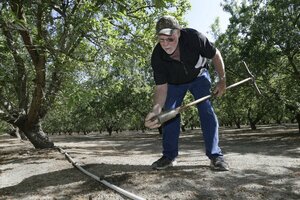California farmers agree to cut water use. Enough to stem the drought?
Riparian water users in the Sacramento-San Joaquin River Delta are voluntarily cutting back farm water in return for certainty through this year’s growing season. It’s a start in curbing agricultural water use in drought-stricken California.

Almond grower Bob Weimer works in his orchard near Atwater, Calif. Some California farmers have agreed to reduce water use by 25 percent in exchange for assurances that they would not face further cuts during the growing season.
Rich Pedroncelli/AP
As drought-stricken Californians came under orders to curb urban water use – up to 36 percent in some communities, thank you very much Gov. Jerry Brown – all eyes turned to farmers. When it takes a gallon of water to produce a single almond, how could they not face a similar mandate, many wondered?
Now the other shoe (or bucket) has dropped, it seems.
On Friday, the State Water Resources Control Board approved a proposal from riparian water right holders in the Sacramento-San Joaquin River Delta to voluntarily cut back water use in exchange for assurances they would not face further riparian curtailment during the June-September growing season.
Under the agreement, participating growers will be able to either reduce water diversions under their riparian rights by 25 percent, or fallow 25 percent of their land below 2013 levels.
“This proposal helps Delta growers manage the risk of potentially deeper curtailment, while ensuring significant water conservation efforts in this fourth year of drought,” water board chair Felicia Marcus said in announcing the agreement. “It allows participating growers to share in the sacrifice that people throughout the state are facing because of the severe drought, while protecting their economic well-being by giving them some certainty regarding exercise of the State Water Board’s enforcement discretion at the beginning of the planting season.”
In other words, save water now or the state may make you lose more water later. Officials say the new plan for Sacramento-San Joaquin River Delta riparian water users nay become a template for other agricultural water users.
The conservation program was proposed by riparian water rights holders – those who own property that abuts a river or stream in the 600,000-acre Sacramento-San Joaquin River Delta and divert water for use on that property.
Junior water right holders in the Sacramento and San Joaquin river watersheds and others have already been curtailed for the second consecutive year, the water board notes. Last year, hundreds of thousands of acres of farmland were fallowed.
Hundreds of farmers are eligible for the new riparian agreement.
“I’m happy to see people working together to find creative ways to stretch the water,” Ellen Hanak, a water expert at the Public Policy Institute of California, told the Sacramento Bee. Peter Gleick, head of the Pacific Institute think tank in Oakland, agreed: “If farmers are willing to take voluntary limits on how much water they use in return for more reliability and less uncertainty, the whole state benefits.”
California produces half of America’s fruits, vegetables, and nuts, so the state can be said to feed the rest of the country. Still, most Americans see drought in the West – parts of Nevada, Oregon, and Utah are parched as well – as a regional problem.
That’s wrong, says Cynthia Barnett, the author of three books on water.
“Drought's consequences also reach beyond the Western states, to grocery stores and East Coast pastureland,” she writes in the Los Angeles Times. “Longer term, persistent drought could push more water-intense crops and livestock from the arid West to the relatively wet East, where many regions are dealing with the twin water woes of scarcity and pollution. As drought has reduced cattle herds across the West, some Eastern states – including Indiana, New York, Ohio and Pennsylvania – have seen an increase in cattle numbers.”
“Several news articles in recent weeks have suggested that Southern cotton-growing states are ideal places to absorb California crops – with no mention of the water strife that plagues the region.
Rice cultivation in Arkansas over the last century has depleted the Mississippi River Alluvial Aquifer by 90 feet. Water has been so mismanaged among Florida, Georgia and Alabama that the states have spent 20 years and millions of dollars fighting in court, when they could have been working together to use less,” Ms. Barnett writes. “Growing the right crops in the right places is a worthwhile goal. But simply moving the problem of over-extraction from one region to another is not the answer.”
To be included in the new riparian agreement in California, participants will have to submit a specific plan to achieve the program’s conservation requirements by June 1, and the State Water Board will conduct spot checks during the growing season.

